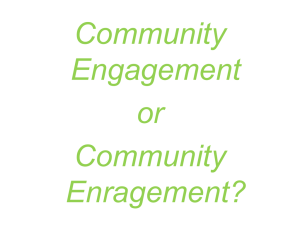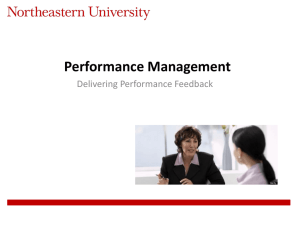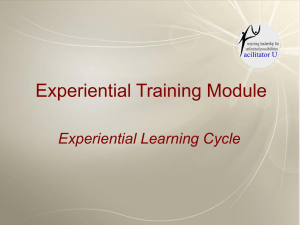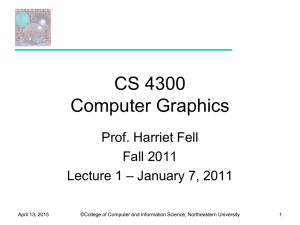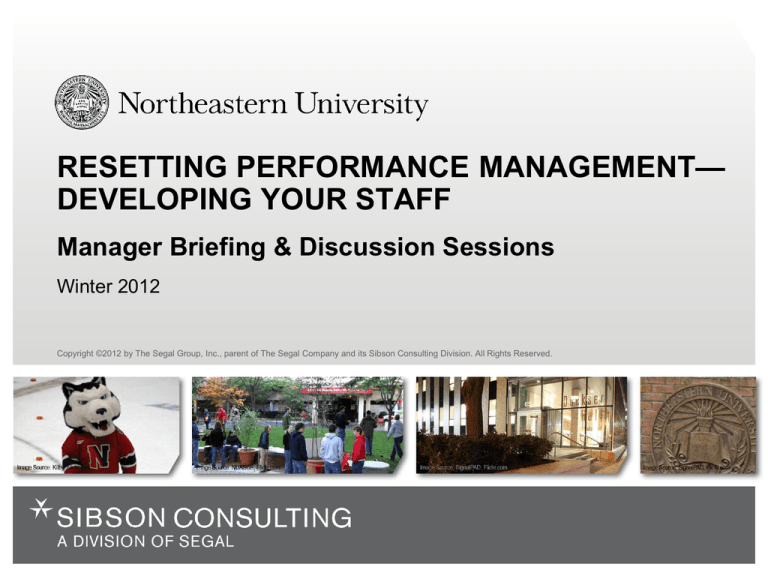
RESETTING PERFORMANCE MANAGEMENT—
DEVELOPING YOUR STAFF
Manager Briefing & Discussion Sessions
Winter 2012
Copyright ©2012 by The Segal Group, Inc., parent of The Segal Company and its Sibson Consulting Division. All Rights Reserved.
This Year’s Cycle
Phase 1
Clarifying and enhancing definitions of ratings
Resetting how ratings were used
Phase 2
Focus on goal setting
Merit increase differentiation
Phase 3
Staff development
Schedule
meetings with your direct
reports and draft reviews
Submit salary
recommendations by
May 4th
Finalize performance review
and hold conversations –
due by April 2nd
1
Today’s Agenda
What do we mean by “Development”?
Group Discussion—Your Most Memorable Development Experience
Your Role as a Manager
A Question of Balance—Learning Orientation and Performance Orientation
A Debrief Tool
Exercise
Providing Feedback
Preparing for this Year’s Cycle
2
Everyone Can Benefit From Development
Filling the
gaps—skills,
knowledge,
performance
Building upon
strengths—skills,
knowledge,
performance, and
deepening
experiences
Expanding
expertise
for future
growth and
advancement
3
Exercise: A Memorable Development Experience
Purpose
Overview
Reflect back on important development experiences
and determine what made them memorable
Consider the types of development
we just discussed
Think back on a development
experience in your career
TIME
10 minutes
Describe the situation. What made
it memorable and why? What did
you get out of it?
We’ll share some of our experiences
4
Your Role as a Manager
Managers play important roles at Northeastern and defining the
expected competencies is essential.
An effective manager at Northeastern …
Pays attention to and addresses others’ capabilities and development needs;
helps identify and close gaps
Effectively gives and receives feedback for growth
Seeks feedback about his or her own performance as a manager; learns from
experience and mistakes
Models desired behavior for peers and subordinates
Delegates for the development of others—encourages others to make
decisions, take responsibilities, and learn from it; “Gets out of the way”
Use the Manager Self-Review to assess
your strengths and plan improvements
5
Your Role as A Manager continued
Get to know your staff member
Goals, interests and aspirations
Strengths and areas for improvement
How they learn
How they see themselves
Use the Employee SelfAssessment form and process
to get to know your staff
member’s perspectives
Actively support and encourage their development
Help them plan and stick to the plan
Provide resources and opportunities as appropriate
Tailor to individual needs and styles
How does he/she learn: Visual, auditory or kinesthetic?
What is his/her focus: Developing or achieving?
Provide clear, supportive, frequent feedback
Positive to reinforce what should be continued
Constructive to redirect or change performance
6
Development Happens Every Day
Courses
and Reading
10%
20%
Feedback
70%
On the Job Experiences,
Tasks and Problem Solving
90% of development opportunities
can happen anytime—look for
developmental, “coaching moments”
Consider the context
Identify goals and needs at the
individual and department level
Use your direct reports’
self-assessments
Find on-the-job opportunities
If appropriate, find stretch
opportunities outside own area
Adapted from research by M.M. Lombardo and R.W. Eichinger for the Center for Creative Leadership
7
A Question of Balance
LEARNING
ORIENTATION
Focus: Improving and
learning.
Implication: “Mistakes”
viewed as a part of the
learning process and
therefore not bad
1
PERFORMANCE
ORIENTATION
Focus: Achievement
and getting ahead
Implication: “Mistakes”
viewed as failures and
to be avoided
Adapted from Dweck, D.S., & Leggett, E.L. (1988), A Social-Cognitive Approach to Motivation and Personality. Psychological Review,
Volume 95, No 2 pp. 256-273
8
Fostering an Environment
of Learning and Development
A DEBRIEF TOOL
What?
To reflect on what happened, what worked and what
could be improved upon
Why?
Supports learning orientation and facilitates improvement
When?
How?
Lessens “scariness” of feedbacks
As soon as possible after the event—memories are
fresh, more efficient than adding to a “To Do” list
Can be a group discussion, or individual exercise
Identify and define action items and follow up
9
Fostering an Environment
of Learning and Development
Customize the debrief
Sample questions:
What happened?
What did you think, feel, say, and do?
What could you have done differently?
What did others say and do?
What was effective?
What was not so effective?
How can you learn from this experience?
10
Exercise: Providing Real Time Feedback
Purpose
Overview
To practice providing feedback to a colleague
Within each group, one volunteer stands
facing the others in the group.
Place an empty container 3 to 5 feet behind
the volunteer—out of view of the volunteer
The volunteer tosses crumpled balls of paper
into the container behind him/her without
looking, aiming to get 3 in. Group members
provide feedback to guide the volunteer
TIME
20 minutes
Repeat exercise with a new volunteer—
move box to a different position for the
new volunteer
11
Feedback Framework©
Feedback is essential to a learning and performance culture
Clear, specific, real-time works best
Provide both positive and constructive
Framework assists in preparing to deliver feedback effectively
Expectations
Outcomes
Observations
Assessments
12
Top 5 Take-Aways
1. Everyday activities create opportunities for feedback and
development
2. 70% of development occurs through job experiences, tasks
and problems solving
3. Create a learning environment to balance with performance—
use the debrief tool, encourage self-reflection
4. Offer effective feedback and reinforcement—clear, specific,
real time
5. Use what has proven effective—employee self-assessments
13
The Performance Management Cycle
I.
Performance
Planning/
Expectation Setting
And is
discussed
here
Development can
be planned here
III.
End of Year
Evaluation
II.
Ongoing
Review and
Feedback
And takes
place here
14
Using the Performance Appraisal to Document
Development Goals and Proposed Actions
IV. DEVELOPMENT DISCUSSIONS
A. Recommendations for Development (List specific recommendations to facilitate continued employee
development for professional growth.)
B. Performance Improvement Requirements (List specific areas in which performance did not meet
expectations and improvement is necessary.)
C. Actions to be taken by Employee/Supervisor (i.e., related to specific recommendations and/or
requirements in either A or B above)
Development activities that specifically support the University and/or Department goals?
V. OVERALL PERFORMANCE RATING
Consistently Exceeds
Frequently Exceeds Fully Meets
Partially Meets Does Not Meet*
* Strongly recommend consultation with Human Resources Management
VI. EMPLOYEE COMMENTS (Optional)
15
Wrap-up – Questions, Comments, Thoughts?
16

